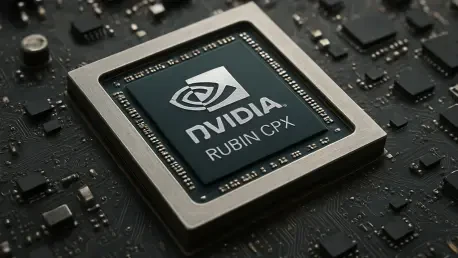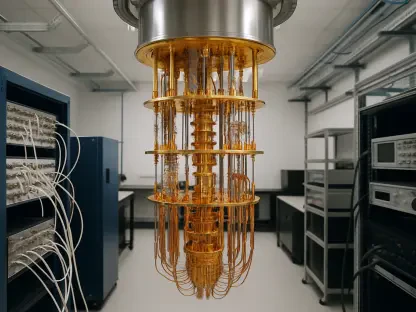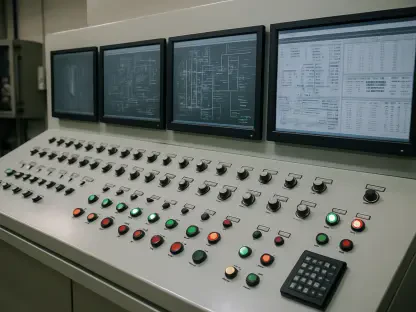In the fast-evolving world of artificial intelligence, where generative platforms process millions of tokens hourly to create everything from text to video, the demand for specialized hardware has never been more critical. Imagine a scenario where an AI service provider struggles with inefficiencies in processing complex queries, costing valuable time and revenue due to outdated GPU architectures. This challenge underscores the need for innovative solutions tailored to specific AI workloads. Enter the Nvidia Rubin CPX chip, a groundbreaking derivative of the Rubin GPU, designed to revolutionize massive-context processing. The purpose of this review is to assess whether this chip represents a worthwhile investment for AI service providers and high-performance computing environments, focusing on its ability to tackle inefficiencies and boost productivity.
Purpose of Reviewing the Nvidia Rubin CPX Chip
The primary goal of this evaluation is to determine if the Rubin CPX chip meets the needs of AI service providers and organizations operating in high-performance computing arenas. With AI workloads becoming increasingly complex, the chip’s potential to address critical bottlenecks in processing is under scrutiny. Specifically, this review aims to gauge its effectiveness for those looking to optimize infrastructure investments while maximizing output in token-driven revenue models.
A significant focus lies in how the Rubin CPX chip confronts challenges within AI inferencing, particularly the inefficiencies observed during the compute-intensive context phase and the memory-heavy decode phase. By targeting these distinct areas, the chip promises to enhance operational efficiency for generative AI platforms that rely on rapid token generation. This capability could translate into substantial productivity gains for businesses handling large-scale queries or content creation.
Additionally, the review explores the broader implications of adopting such specialized hardware. The potential to increase revenue through faster processing of complex tasks, such as video generation, positions the Rubin CPX as a tool for forward-thinking companies. This analysis seeks to provide clarity on whether the chip delivers on these promises, helping stakeholders make informed decisions about integrating it into their systems.
Overview of the Nvidia Rubin CPX Chip Technology
The Rubin CPX chip, derived from the upcoming Rubin GPU, emerges as a specialized solution crafted for massive-context processing within AI workloads. Unlike traditional GPUs that handle multiple phases of inferencing with varying efficiency, this chip is engineered to excel in the compute-intensive context phase. Its design prioritizes optimization for tasks that demand high computational power, making it a targeted asset for AI factories and service providers.
Key technical features set the Rubin CPX apart, including an impressive 30 petaFLOPs of compute performance using NVFP4 precision and 128GB of cost-effective GDDR7 memory. Notably, it forgoes NVLink interconnects, a decision that enhances affordability compared to counterparts using pricier HBM4 memory. These specifications, combined with integration into advanced networking platforms like Quantum-X800 InfiniBand and Spectrum-X Ethernet, ensure robust connectivity for large-scale operations while maintaining a focus on economic accessibility.
The chip’s intended applications include accelerating the context phase of AI inferencing and supporting resource-heavy tasks like generative video applications, which can consume vast amounts of tokens per hour. A standout selling point is its reported ability to deliver attention capabilities three times faster than the GB300 NVL72 systems. This performance edge, paired with a design tailored for specific AI needs, positions the Rubin CPX as a compelling choice for environments where speed and specialization are paramount.
Performance Analysis of the Rubin CPX Chip
When examining the Rubin CPX chip’s performance in real-world AI scenarios, its capacity to accelerate token generation for generative platforms stands out. The chip is built to handle the immense computational demands of processing complex queries, ensuring that AI systems can produce outputs swiftly. This efficiency is crucial for service providers whose revenue models depend on the rapid creation of tokens, especially in applications involving intricate data sets or multimedia content.
Delving into specific metrics, the chip powers configurations like the Vera Rubin NVL 144 CPX rack, which offers 8 exaFLOPs of compute power and 100TB of fast memory in a single-rack setup, alongside 1.7 PB/s of memory bandwidth. In dual-rack arrangements, flexibility is provided by separating context processing tasks, achieving performance levels up to 7.5 times faster than the GB300 NVL72 system. These figures highlight the chip’s potential to transform the scale and speed at which AI workloads are managed.
Further assessment reveals the Rubin CPX’s prowess in managing massive token processing, particularly for video content generation that may require up to one million tokens per hour. Such capabilities ensure that tasks which once took days can be completed far more efficiently. Compared to existing systems, the chip’s targeted design offers a clear advantage in specialized environments, making it a strong contender for organizations focused on high-throughput AI inferencing.
Strengths and Limitations of the Rubin CPX Chip
Among the notable strengths of the Rubin CPX chip is its specialized architecture for context phase processing, which addresses a critical gap in traditional GPU performance. The use of cost-effective GDDR7 memory instead of more expensive alternatives enhances its appeal for budget-conscious organizations without sacrificing power. Additionally, the flexibility of rack configurations, such as the Vera Rubin NVL 144 CPX, allows for tailored solutions to meet diverse operational needs.
Another advantage lies in the chip’s potential economic impact for AI factories. Nvidia claims that infrastructure investments in this technology could yield significant returns, with projections suggesting $5 billion in revenue for every $100 million spent. This promise of high profitability, combined with the chip’s ability to streamline token generation, makes it an attractive option for businesses aiming to scale their generative AI services.
However, limitations exist, such as the absence of NVLink interconnects, which may hinder performance in high-bandwidth scenarios outside its primary focus. The delayed availability until the end of 2026 also poses a challenge for companies needing immediate solutions. Furthermore, balancing compute and memory demands for workloads not aligned with the context phase could present difficulties, requiring careful consideration of the chip’s applicability to specific use cases.
Final Assessment and Recommendation
The evaluation of the Rubin CPX chip reveals a pioneering approach to AI inferencing, underscored by its remarkable technical specifications and targeted design. Its focus on optimizing the context phase offers a fresh perspective on tackling inefficiencies that plague traditional GPU setups. For AI service providers, the chip’s performance metrics and cost-effective memory solutions present a compelling case for adoption.
Based on the analysis, a recommendation emerges for organizations prioritizing efficiency in generative AI workloads, particularly those centered on massive-context processing and token revenue. The Rubin CPX stands as a strong contender, delivering substantial compute power and flexibility in configurations. Its affordability further enhances its suitability for businesses looking to maximize returns on infrastructure investments.
However, potential adopters must plan for the chip’s release timeline at the end of 2026, ensuring that their strategic roadmaps align with this availability. For entities focused on specialized AI tasks and willing to adapt to the chip’s unique strengths, the Rubin CPX offers a promising path toward enhanced productivity. This assessment affirms its value in the evolving landscape of high-performance computing.
Concluding Thoughts and Practical Advice
Reflecting on the evaluation, the Rubin CPX chip emerges as a transformative force in specialized AI hardware, showcasing Nvidia’s commitment to pushing boundaries with tailored computing solutions. Its introduction marks a shift toward addressing specific phases of AI workloads with precision, setting a benchmark for future innovations. The potential it unlocks for generative platforms is evident in its performance capabilities.
For AI service providers and high-performance computing entities considering this technology, a practical next step involves mapping out workload requirements against the chip’s strengths in context processing. Budget constraints also need careful evaluation to ensure alignment with the economic benefits projected by such an investment. Exploring pilot implementations or phased integrations could mitigate risks associated with its delayed rollout.
Looking ahead, stakeholders are advised to assess infrastructure scalability, particularly with configurations like the Vera Rubin NVL 144 CPX rack, to future-proof their operations. Engaging with Nvidia’s ecosystem of networking solutions could further optimize outcomes. These considerations provide a roadmap for harnessing the chip’s capabilities, ensuring that adopters maximize efficiency and stay competitive in the dynamic AI landscape.









